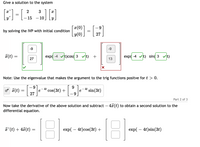Give a solution to the system -Lis -10. 2 3 - 15 ¤(0) by solving the IVP with initial condition y(0). 9. 27 181 #(t) exp( t)cos( t) + exp( t) sin( t) Note: Use the eigenvalue that makes the argument to the trig functions positve for t > 0.
Give a solution to the system -Lis -10. 2 3 - 15 ¤(0) by solving the IVP with initial condition y(0). 9. 27 181 #(t) exp( t)cos( t) + exp( t) sin( t) Note: Use the eigenvalue that makes the argument to the trig functions positve for t > 0.
Calculus: Early Transcendentals
8th Edition
ISBN:9781285741550
Author:James Stewart
Publisher:James Stewart
Chapter1: Functions And Models
Section: Chapter Questions
Problem 1RCC: (a) What is a function? What are its domain and range? (b) What is the graph of a function? (c) How...
Related questions
Question

Transcribed Image Text:Give a solution to the system
2
3
- 15
- 10
x(0)
by solving the IVP with initial condition
y(0)
27
# (t) =
exp
t)cos(
t) +
exp(
t) sin(
t)
Note: Use the eigenvalue that makes the argument to the trig functions positve for t > 0.
Expert Solution
This question has been solved!
Explore an expertly crafted, step-by-step solution for a thorough understanding of key concepts.
This is a popular solution!
Trending now
This is a popular solution!
Step by step
Solved in 3 steps with 3 images

Follow-up Questions
Read through expert solutions to related follow-up questions below.
Follow-up Question

Transcribed Image Text:Give a solution to the system
2
3
- 15
- 10.
x(0)
by solving the IVP with initial condition
y(0)
27
-9
-9
(t)
exp( -4 vt)cos( 3 vt) +
exp( -4 vt) sin( 3
Vt)
27
13
Note: Use the eigenvalue that makes the argument to the trig functions positve for t > 0.
-6-
of #(t)
4t
e
9.
cos(3t) +
4t
e
sin(3t)
27
Part 2 of 3
Now take the derivative of the above solution and subtract – 4x (t) to obtain a second solution to the
differential equation.
18
'(t) + 47(t) =
exp( – 4t)cos(3t) +
exp( – 4t)sin(3t)
Solution
Recommended textbooks for you

Calculus: Early Transcendentals
Calculus
ISBN:
9781285741550
Author:
James Stewart
Publisher:
Cengage Learning

Thomas' Calculus (14th Edition)
Calculus
ISBN:
9780134438986
Author:
Joel R. Hass, Christopher E. Heil, Maurice D. Weir
Publisher:
PEARSON

Calculus: Early Transcendentals (3rd Edition)
Calculus
ISBN:
9780134763644
Author:
William L. Briggs, Lyle Cochran, Bernard Gillett, Eric Schulz
Publisher:
PEARSON

Calculus: Early Transcendentals
Calculus
ISBN:
9781285741550
Author:
James Stewart
Publisher:
Cengage Learning

Thomas' Calculus (14th Edition)
Calculus
ISBN:
9780134438986
Author:
Joel R. Hass, Christopher E. Heil, Maurice D. Weir
Publisher:
PEARSON

Calculus: Early Transcendentals (3rd Edition)
Calculus
ISBN:
9780134763644
Author:
William L. Briggs, Lyle Cochran, Bernard Gillett, Eric Schulz
Publisher:
PEARSON

Calculus: Early Transcendentals
Calculus
ISBN:
9781319050740
Author:
Jon Rogawski, Colin Adams, Robert Franzosa
Publisher:
W. H. Freeman


Calculus: Early Transcendental Functions
Calculus
ISBN:
9781337552516
Author:
Ron Larson, Bruce H. Edwards
Publisher:
Cengage Learning